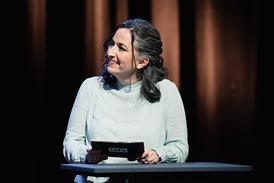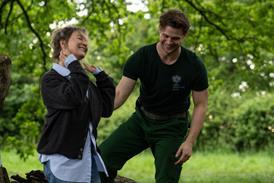Speaking at the 3D Creative Summit, the Life of Pi Oscar winner tells filmmakers to learn new cinematic language themselves and “don’t trust anybody”.
Ang Lee, the recent Best Director Oscar winner for his first 3D film Life of Pi, says he’s enjoying the challenge of working in a new format and plans to continue working in 3D on some projects, to become one of the “trailblazers” of this new cinematic language.
“I think 3D actually is an advantage to make things look realistic,” he said, speaking from New York via videolink to the 3D Creative Summit in London.
“We associate 3D with action and spectacular scenes or movement, but I think 3D should be used in drama because it gives volume, it gives you so much realism. I think that’s the advantage.”
He continued: “For over 100 years, the viewer’s eyes compensate the lack of volume in 2D, so we actually see 3D in a 2D media. When you pick up something that actually has volume I think the whole rules of the game should be gradually changed.
“I think we are in the transition, we’re making adjustment for that. The new illusion of cinema is not the depth you see in real life, it’s not flat either, it’s it’s own thing.”
Still a novice
He said that even after learning about 3D for four years making Life of Pi, he’s still a newcomer.
“I dare to say I’m a novice of the new cinematic language of 3D,” added Lee.
“There is so much I don’t know, I still want to learn so much…When things are cheaper and more convenient, and the equipment gets better and faster, I think we are going to learn that language a lot better than the information I had.
“This is something nobody could teach me, you have to have your own language. The language has to be this language between you and the audience and we’re not there yet.
“I think that animation is far ahead of live action [in 3D] but for live action cinema I think we’re still learning, we’re still babies. “
Trailblazer ambition
He says he will work in 3D again “if I can afford it,” meaning on movies of a certain scale.
“For a normal-budget movie, I will try it again, there is so many things to learn about this new medium,” Lee explained.
“I want to learn, I want to be one of the trailblazers discovering that language. But if I’m going to do, let’s say, a low-budget New York film, I can’t afford it.”
He said that 3D shouldn’t just be associated with expensive action movies, and it should demand respect.
“I think we should discover what 3D is, it’s just different than 2D. It’s still cinema, it’s a theatrical experience.”
Glasses gripe
Lee’s one quibble about 3D is the glasses for the audience and he said: “I don’t personally like the glasses. I hope some smart guy can figure a way to get rid of them.
But his new fascination with 3D doesn’t mean he is abandoning 2D. “I love them both. Like everybody I am so attached to the filmmaking, there are such great artists and great history and it’s part of our life, but 3D is something that I think is very exciting.”
Life of Pi
Looking back at Life of Pi, now a huge box-office smash and triple Oscar winner, Lee says he had read Yann Martel’s book and found it inspiring philosophically but “I didn’t think it was filmable,” when Fox first approached him about the project.
Then he had an idea. “One day when I was working on the first draft, I just thought, what about 3D? With another dimension, I could pull this off,” Lee recalls.
“Of course this was six months before I even saw Avatar… I had no reference of what I was thinking.”
He continued: “I thought of it from the beginning of the project. I was thinking it was 3D that dared me to take on this challenge. At that time I didn’t know how to make this movie in the movie language which I know, which is 2D.
“I think I just needed that third dimension to make the water become a character, to involve the audience in a way so that they experience what Pi experiences.
“You feel yourself in Pi’s position. If that was in 2D, I don’t think I could pull it off that effectively. It looked more like a stage, because it has actual volume. But it’s not a stage that you are seeing. – it can be moved.”
Tiger challenge
Making the tiger, Richard Parker, look realistic was one of the biggest hurdles. Lee and his team studied and filmed actual tigers and combined that with 3D animation.
He explained: “The thing about a real tiger mixed with an animation tiger, is that it raised the bar. I told the animator, we have to cut your tiger with a real tiger.
“The advantage I had - compared to something like Hulk - is that we had a real thing to observe.
“We shot tons of footage of the tiger, so we could watch the tiger down to these very details, little twitches of the whiskers and hair. And how they coordinate and twitch their tails. It’s a long struggle to get it done right. “
3D emotion
Lee said the audience can be drawn into the emotion of a film in a different way as a result of 3D.
“Because Pi is in your space, you’re looking at the same thing he’s looking at,” he said. “You envision yourself doing it. I don’t think you quite get that in 2D.
“If I was to do that shot in 2D I would need three shots, the establish, the boat, and a close shot of Pi’s face for his reaction… that’s how I would do that in 2D. but in 3D you’re there, you’re experiencing it. I think it’s quite an advantage.”
Lee sees 3D as central to the process, something that every director has to learn for himself.
“3D is not visual effects…the stereographer should be the filmmaker himself,” he added.
“The director, the filmmaker, should make that decision the same way we choose lenses, where to put the camera, to decide how to use it. The best way to learn is like swimming you just jump in and do it… should experience it for yourself and build your own language.
“There are so many things about 3D that we should learn and explore and enjoy.”
Call to arms
When asked about what budding filmmakers need to know about trying new formats, he said: “Don’t trust anybody. Including myself.
“If anybody tells you what you need they are bullshitting you… Learn from other people but don’t completely trust them.”
He ended on a bullish call to arms for more filmmakers to work in 3D: “Let’s be humble and be brave and make a lot of mistakes but let’s discover this language, it’s a legitimate one.”
The film’s visual effects consultant David Conley also spoke about the complex process of making the film.
The inaugural 3D Creative summit continues today [March 28], with speakers including Sky 3D director John Cassy; Aardman Animations’ Frank Passingham and Tom Barnes; Park Road Post’s Phil Oatley; and renowned filmmaker David Attenborough.
Screen International is a media partner of the event, which is backed by Creative Skillset, Sky 3D, Onsight, Deluxe Digital Cinema, SGO, Meduza, Vision3, Ravensbourne and the International 3D Society.




































1 Readers' comment